Food
Genoa Salami: History, Taste, and How It’s Made
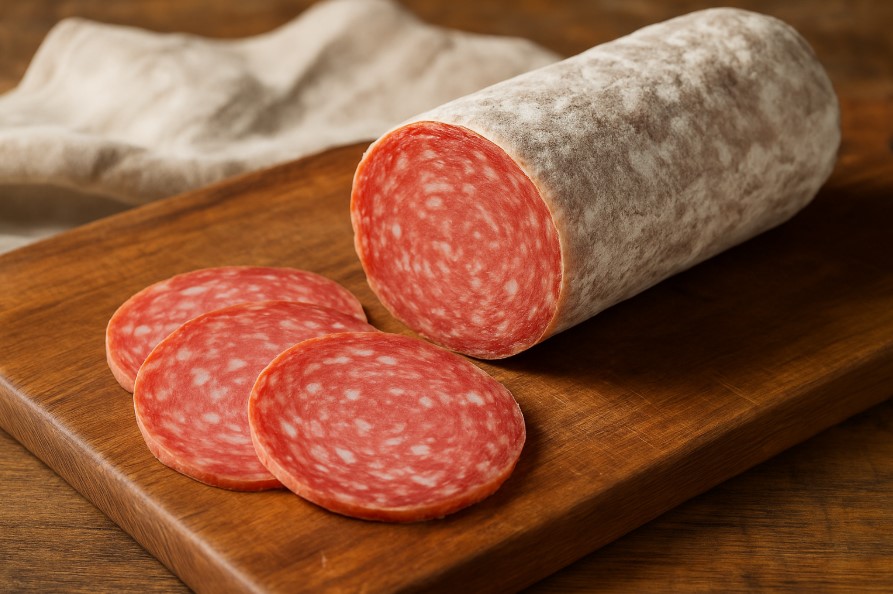
Genoa salami is one of the most popular types of salami in the world. Known for its rich flavour and smooth texture, it is a favourite ingredient in sandwiches, charcuterie boards, and pasta dishes. It comes from the region of Genoa in northern Italy and has a long history rooted in traditional Italian food culture. Understanding where it comes from, how it tastes, and how it is produced helps explain why it has become a common item in kitchens and restaurants across many countries.
The History of Genoa Salami

The origins of Genoa salami can be traced to the Liguria region in northwestern Italy, where the city of Genoa is located. This area has a mild coastal climate and a long history of food preservation techniques, including curing meats. For centuries, farmers and butchers developed ways to preserve meat without refrigeration. Curing with salt, drying in controlled air environments, and adding spices became traditional practices.
In medieval times, salami was a practical way to store meat for long periods. It could be made from pork or a mix of pork and beef, combined with salt and spices, and then dried for weeks or months. These methods allowed families to have a reliable food source during the year. Genoa became a trading hub in the Mediterranean, and its food culture spread to other regions. The local style of salami gained a reputation for its balanced seasoning and smooth texture.
As Italian immigrants moved to other countries in the 19th and 20th centuries, they brought their food traditions with them. Genoa salami became known in places like the United States, Canada, and South America. Over time, local versions were created based on the original recipes, often using regional meats and spices. Despite these changes, the name still refers to the style developed in Genoa.
Taste and Texture of Genoa Salami
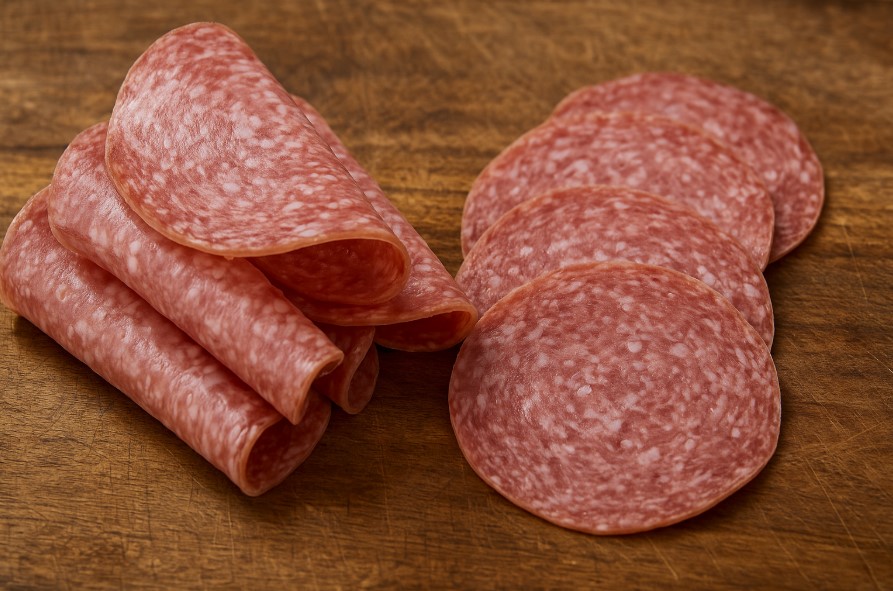
Genoa salami is known for its mild yet rich flavour. It is usually made from finely ground pork, sometimes mixed with small amounts of beef or veal. The seasoning is balanced and includes salt, garlic, black pepper, and wine. This gives it a slightly tangy taste that is not too strong but still distinct.
The texture is smooth and soft compared to other types of salami. This is because the meat is ground more finely, and the curing process keeps more moisture in the product. When sliced thin, it has a tender bite and almost melts in the mouth. The fat content is also slightly higher, which gives it a creamy feel.
Genoa salami is usually not spicy. This makes it different from southern Italian salamis, which often use hot chilli peppers. Its mild flavour allows it to blend well with cheeses, breads, and vegetables without overpowering them. The balance of salt and acidity from the curing process creates a clean taste that works well in many dishes.
Ingredients Used in Genoa Salami
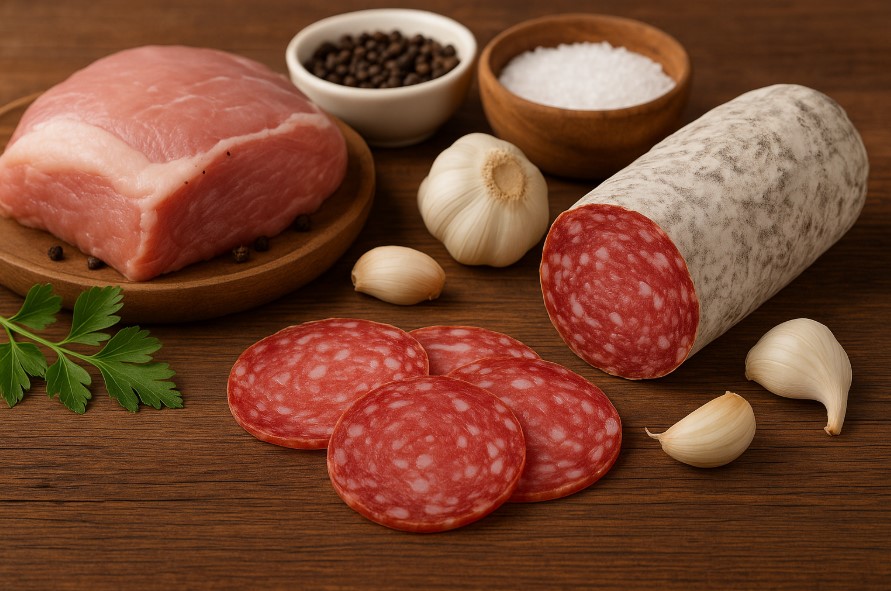
The main ingredient in Genoa salami is pork. High-quality cuts with a good balance of lean meat and fat are chosen. In some recipes, small amounts of beef or veal are added to change the texture or flavour slightly.
Salt is essential because it draws moisture out of the meat and prevents bacterial growth. Garlic is often added for flavour, either fresh or in powdered form. Black pepper provides a mild spice. Red or white wine is included in many traditional recipes to add acidity and depth of flavour. Some versions also include sugar in small amounts to balance the salt.
Starter cultures are used in commercial production to control the fermentation process. These are safe bacteria that help lower the pH of the meat, which makes it safe to eat and gives it its characteristic tang. Natural or artificial casings are used to shape the salami during curing.
The Production Process
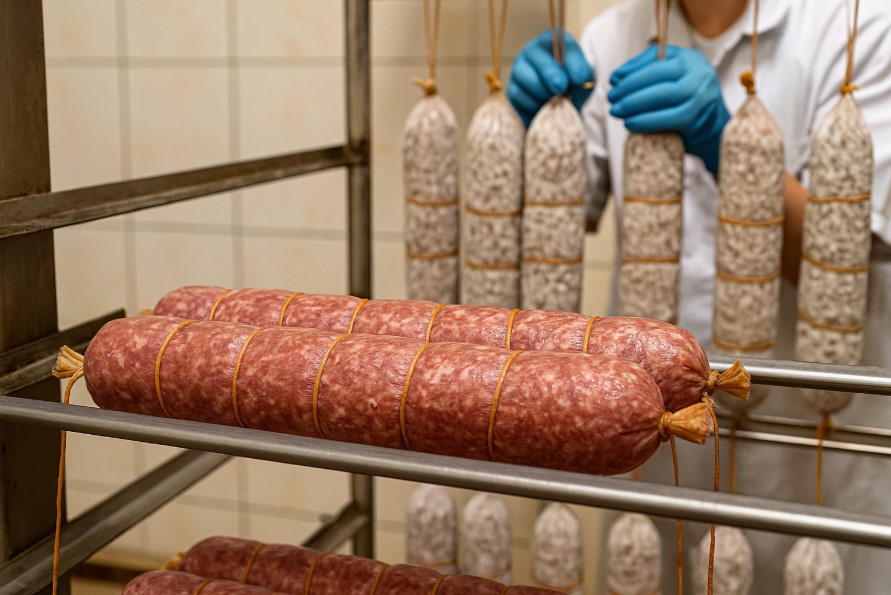
Making Genoa salami involves several careful steps. The process is designed to remove moisture, develop flavour, and make the product safe to eat.
First, the meat and fat are ground. The grinding is finer than for many other salamis, which gives Genoa salami its smooth texture. The ground meat is mixed with salt, spices, wine, and starter cultures. This mixture is kneaded until it becomes uniform.
Next, the mixture is stuffed into casings. Traditionally, natural casings made from animal intestines are used, but collagen casings are also common today. The filled salamis are then tied with string or netting to hold their shape.
Fermentation comes next. The salamis are kept at a warm temperature for one to three days. During this time, the starter cultures produce lactic acid, which lowers the pH of the meat and makes it safe. The acidity also gives Genoa salami part of its flavour.
After fermentation, the salamis are moved to a cool, humid room to cure. This is where they slowly dry and develop their final taste. The curing process can take from three to eight weeks, depending on the size of the salami and the desired texture. Airflow, humidity, and temperature are carefully controlled to prevent spoilage.
Once the salamis have lost the right amount of moisture and reached the correct texture, they are packaged and stored. They can then be sold whole or sliced.
Safety and Quality Control
Producing Genoa salami requires strict safety measures because it is not cooked. The curing and fermentation steps are carefully monitored to prevent harmful bacteria from growing. Modern producers follow food safety regulations and test their products for pH, moisture content, and microbial safety before selling them.
The use of starter cultures has improved safety compared to older methods that relied only on natural fermentation. These cultures make the process more predictable and consistent. Many producers also use controlled environments for curing, with precise temperature and humidity settings.
High-quality Genoa salami is made from good cuts of meat, clean fat, and natural seasonings without fillers or artificial flavours. Some artisanal producers in Italy still follow traditional methods, while larger companies may use modern equipment to produce large quantities with the same flavour.
How Genoa Salami is Different from Other Salamis
There are many types of salami, and Genoa salami has several qualities that make it different. It has a finer grind, giving it a smoother texture than coarse salamis like soppressata or Milano salami. It has more moisture than dry, hard salamis and does not become crumbly when sliced.
Its flavour is mild and balanced. It lacks the strong spices or hot peppers used in southern Italian salamis. It also does not use heavy smoking, which gives some central European salamis a stronger flavour. Instead, Genoa salami relies on careful curing and simple spices.
The fat in Genoa salami is well mixed into the meat, creating a marbled look. This gives it a creamy taste when eaten. In contrast, hard salami has larger chunks of fat and is drier. Genoa salami is often preferred in sandwiches because it is soft and easy to bite.
Common Culinary Uses
Genoa salami is versatile in cooking. It is often used as a cold cut in sandwiches and subs. Its mild flavour pairs well with cheeses like provolone, mozzarella, or cheddar. It can be added to charcuterie boards with crackers, olives, and fruit.
It is also used on pizzas, either as slices or chopped into small pieces. It adds a savoury flavour without overpowering other toppings. In pasta dishes, thin slices of Genoa salami can be tossed with olive oil, garlic, and vegetables to make a quick meal.
Chopped Genoa salami can be added to salads for extra flavour and protein. It also works well in baked dishes like casseroles or quiches. Because it is already cured, it does not need additional cooking and can be eaten directly from the package.
Nutritional Profile of Genoa Salami
Genoa salami is a cured meat product, so it is rich in protein and fat. A typical serving of about 28 grams (one ounce) contains around 110 to 130 calories. It has about 6 grams of protein, 10 grams of fat, and 1 gram of carbohydrates. The fat content gives it a creamy texture and flavour. It also contains sodium from the curing process, usually about 400 to 500 milligrams per serving.
It provides small amounts of vitamins and minerals such as vitamin B12, niacin, zinc, and iron. These nutrients support energy production and red blood cell health. However, because it is a processed meat, it should be eaten in moderation. It is often high in saturated fat and sodium, which can be a concern if eaten in large amounts regularly.
Many commercial producers now offer reduced-sodium or lower-fat versions. Checking the nutrition label can help you choose a product that fits your dietary needs.
Storage and Shelf Life
Genoa salami has a long shelf life because it is cured and dried. Whole, unopened salami can last for several months in a cool, dry place. Once opened, it should be wrapped tightly and stored in the refrigerator. Sliced salami should always be kept in the fridge and eaten within two to three weeks for best quality.
If mould forms on the surface of whole salami, it is usually harmless and can be wiped off with a clean cloth. This white mould is part of the natural curing process and helps protect the salami. However, if there is green, black, or fuzzy mould, or if the salami smells sour or rotten, it should be discarded.
Freezing is also possible, but it can change the texture slightly. If freezing, wrap it tightly to prevent freezer burn, and thaw it slowly in the refrigerator.
Buying Tips
When buying Genoa salami, look for even marbling, which means the fat and meat are well mixed. The colour should be a rich red with white specks of fat. Avoid products that look grey or have wet spots, as this could indicate poor storage.
Read the ingredients label. Traditional Genoa salami should contain pork, salt, spices, and possibly wine. It should not have fillers, starches, or artificial flavourings. Some producers add preservatives like sodium nitrate or sodium nitrite to prevent bacterial growth and maintain colour. These are common and considered safe in small amounts, but if you want to avoid them, look for nitrate-free options.
If buying from a deli, ask when it was sliced and how it was stored. Freshly sliced salami has the best texture and flavour. Whole salami will last longer than pre-sliced packs.
Serving Ideas
There are many ways to serve Genoa salami. Here are some common and simple ideas:
- Sandwiches: Layer slices with cheese, lettuce, tomato, and condiments on bread or rolls.
- Charcuterie boards: Arrange slices with cheeses, crackers, nuts, fruits, and olives.
- Salads: Cut into thin strips and add to green salads or pasta salads.
- Pizza topping: Place thin slices on homemade or store-bought pizza before baking.
- Snacks: Roll slices with cheese or vegetables for quick snacks.
- Breakfast dishes: Add chopped salami to scrambled eggs, omelets, or breakfast burritos.
- Appetisers: Wrap slices around breadsticks, melon pieces, or mozzarella sticks.
These serving methods make use of its soft texture and mild flavour. Because it is fully cured, it does not need cooking, which makes it convenient.
Genoa Salami in Global Cuisine
While it started in Genoa, this salami has spread worldwide and is now part of many international cuisines. In the United States, it is common in Italian-American deli sandwiches, often paired with provolone cheese and lettuce. It is also popular on cold-cut platters at parties.
In South America, especially Argentina and Brazil, local versions of Genoa-style salami are made with regional spices and are eaten with bread and cheese. In northern Europe, it appears in open-faced sandwiches and cold breakfast platters.
Although different regions make their own versions, the core characteristics remain: fine texture, balanced seasoning, and gentle curing. This shows how flexible it is in different food traditions.
Traditional Production vs Modern Production
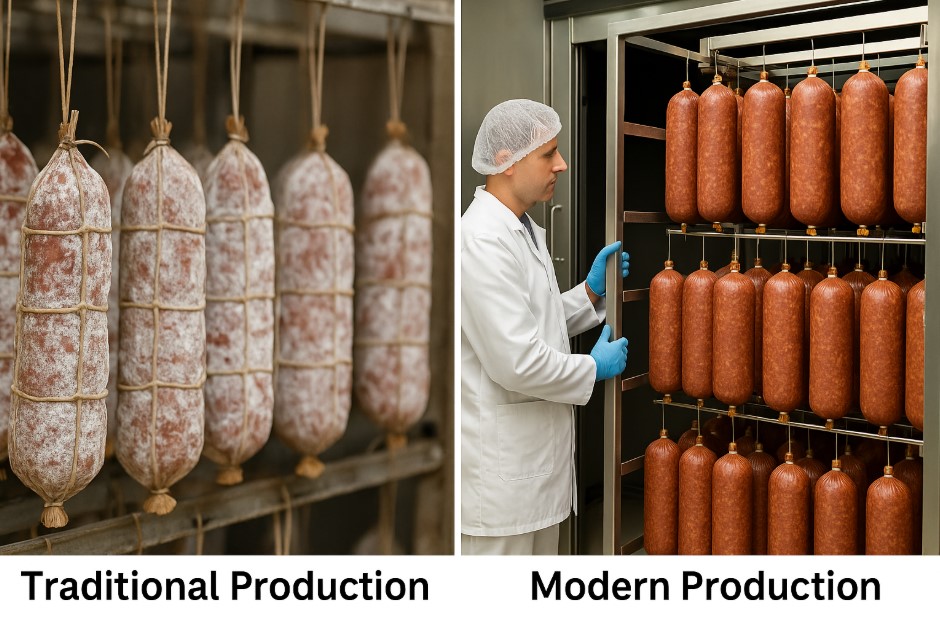
Traditional production methods rely on natural fermentation and drying. Small-scale artisans often use local pork and natural casings, and they cure the salami in ageing rooms with natural airflow. These methods produce a rich flavour and firm but soft texture. The process can take many weeks and requires careful monitoring.
Modern production often uses starter cultures to control fermentation, mechanical drying rooms for faster curing, and standardised recipes for consistency. This allows producers to make large amounts with reliable quality and safety.
While traditional methods are prized for their flavour, modern methods make Genoa salami more widely available. Many high-quality producers use a mix of traditional techniques and modern technology to keep flavour while meeting safety rules.
Regulations and Standards
In Italy, traditional Genoa-style salami is regulated under European Union food laws. Producers must follow hygiene standards and label ingredients clearly. In other countries, food safety agencies also regulate production to prevent contamination.
All commercial Genoa salami must meet microbiological safety limits, including pH levels and water content. These rules protect consumers from harmful bacteria like Salmonella or Listeria. Labels must list ingredients, weight, storage instructions, and expiry dates.
These regulations help ensure that even mass-produced products are safe and consistent. They also protect the reputation of traditional styles by setting quality standards.
Cultural Importance
Genoa salami is more than just a food product. It is part of the culinary heritage of northern Italy. It represents centuries of local craftsmanship and food preservation knowledge. In Genoa and surrounding regions, it is often included in traditional meals during festivals and family gatherings.
It also reflects the influence of Italian cuisine worldwide. As immigrants spread Italian food traditions, Genoa salami became a symbol of Italian-style cured meats. Today, it is common in supermarkets around the world, showing how local traditions can become part of global food culture.
How to Make Genoa Salami at Home
It is possible to make Genoa salami at home, though it requires care and proper equipment. Here is a general overview of the steps:
- Ingredients:5 kg of pork shoulder, 0.5 kg of pork fat, 60 g of salt, 6 g of curing salt, 10 g of black pepper, 20 g of garlic, 200 ml of dry white wine, and starter cultures.
- Preparation: Grind the meat and fat finely. Mix with salt, spices, garlic, wine, and starter cultures until sticky.
- Stuffing: Fill the mixture into casings, pressing out air bubbles. Tie tightly with string.
- Fermentation: Hang at 22°C with high humidity for 48 hours to let the starter cultures lower the pH.
- Drying and curing: Move to a curing chamber at 12–15°C with 75% humidity for 4–6 weeks. Turn occasionally.
- Testing: When the salami has lost about 30% of its weight, it is ready.
This process requires food-safe equipment, accurate temperature and humidity control, and proper hygiene. Because of the risk of bacteria, beginners should study food safety carefully or start with simpler cured meats first.
Final Thoughts
Genoa salami has a long history that started in the Liguria region of Italy. It is known for its soft texture, balanced seasoning, and rich flavour. It is made from finely ground pork mixed with salt, garlic, black pepper, and wine, then fermented and cured for several weeks.
It became popular worldwide as Italian immigrants introduced it to other countries. Today, it is produced both traditionally and on a large scale. It is used in many dishes, including sandwiches, salads, pizzas, and appetisers.
While it is high in protein and flavourful, it also contains saturated fat and sodium, so it is best enjoyed in moderation. Choosing quality products, storing them properly, and pairing them with other foods can help you enjoy it safely and fully.
Understanding its history, taste, and production shows why this traditional Italian salami has remained popular for centuries and continues to be enjoyed around the world.
Learn about: Hard Salami: History, Taste, and How It’s Made
-

 Social Media2 months ago
Social Media2 months agoWhat the “67” TikTok Meme Really Means
-

 Tech2 months ago
Tech2 months agoWhat To Do When Your Business Faces Network Vulnerabilities
-

 Self Improvement2 months ago
Self Improvement2 months agoUsing BCBS Rehab to Access Quality Addiction Care
-

 Games2 months ago
Games2 months agoPusoy Strategies for Play That Also Work in Pusoy Dos in English






